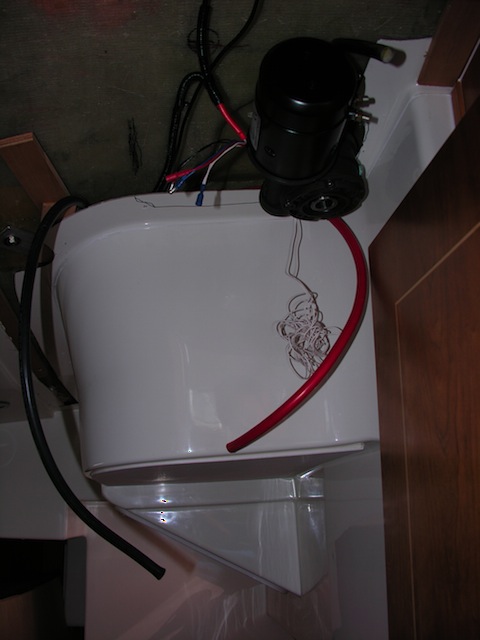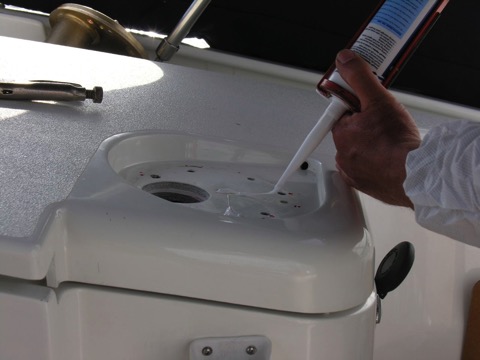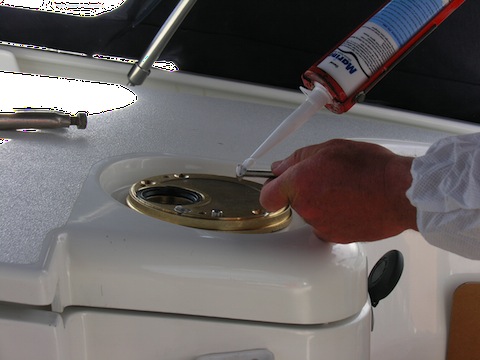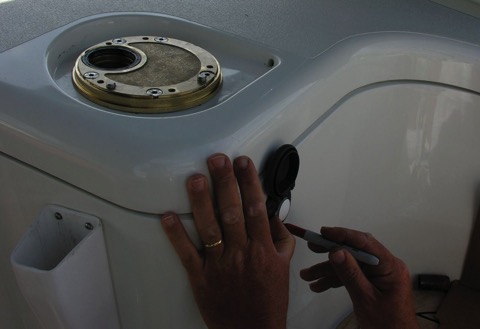Electric Winch
17/06/10 07:27 Filed in: Rigging | Electrical
Why go electric?
I have often wondered about adding an electric winch. As boats get bigger, as we get a bit older, or just lazier, it might seem like a good idea. I also wonder if there are times I might not bother raising the main for just a shorter sail and just putting the jib out because its easy! I guess that means I am lazier ;-) Anyway with the new 49 footer it was time to think about the question again.
Raising the main on the 49 is just that much more work than the 42. With the 42 I could raise the sail to within 3 feet of the masthead and just winch it the last bit. The job is a tough one first thing in the morning (and honestly a bit much for Sheryl I think). When we were spec’ing out the 49 I wondered if we would need an electric halyard winch but decided to wait and see. The sail is 33% larger than the one on our 42 and I would guess roughly that much heavier.
Now that we have had the boat for a few months and sailed her in a variety of conditions we have found out just how much difference there is between the two. Without the winch I can pull the sail up just above the upper spreaders. That is a tough pull then there is still almost 20 feet left to winch. So it was definitely time to go for an electric halyard winch.
Adding the winch turned out to be a medium sized job in two main parts...
In this case the installation was much simpler since we were converting the existing Lewmar winch to power. All Lewmar winches sold in the last number of years are easily convertible using a standard conversion kit. So we would be using the same winch and just adding a new base plate, and motor assembly belowdecks.
Running the wire

Heavy wiring installed ready to connect to winch
Installing the winch
In our case I was converting the halyard winch which is on the cabin top so we had to carefully consider where the motor would intrude the least into the cabin. The winch itself will have a new base plate and a gear shaft that allows the motor below to drive the winch. This requires a new large hole drilled in the deck. Always fun drilling a big hole in your new boat!!

After final fitting the new base plate is set down with silicone.

I mounted the switch under the winch checking so we could see the main while pushing the button.

Using the winch
Our first outing with the new winch was for our 30 mile sail down the English Channel to Brighton. A mid afternoon departure was dictated by the tides so 1500 hours saw us heading into the wind in the Solent. Raising the main was a dream! What a pleasure to just push the button and watch the sail go up. On to Brighton, then Ramsgate, then across to Holland!
One useful technique we have seen on other boats is to use the halyard winch for other jobs as well. In our case we can also lead other lines to the electric winch. Our two forward furled sails also require a good healthy pull. They can be winched by the aft cockpit winches but it is a long chore in heavy wind. Now I can lead the furling line with just one turn around the cockpit winch then up to the electric winch. What a great advantage!! One electric winch doing quite a few of the heaviest winching jobs. It was certainly a conversion well worth doing.
I have often wondered about adding an electric winch. As boats get bigger, as we get a bit older, or just lazier, it might seem like a good idea. I also wonder if there are times I might not bother raising the main for just a shorter sail and just putting the jib out because its easy! I guess that means I am lazier ;-) Anyway with the new 49 footer it was time to think about the question again.
Raising the main on the 49 is just that much more work than the 42. With the 42 I could raise the sail to within 3 feet of the masthead and just winch it the last bit. The job is a tough one first thing in the morning (and honestly a bit much for Sheryl I think). When we were spec’ing out the 49 I wondered if we would need an electric halyard winch but decided to wait and see. The sail is 33% larger than the one on our 42 and I would guess roughly that much heavier.
Now that we have had the boat for a few months and sailed her in a variety of conditions we have found out just how much difference there is between the two. Without the winch I can pull the sail up just above the upper spreaders. That is a tough pull then there is still almost 20 feet left to winch. So it was definitely time to go for an electric halyard winch.
Adding the winch turned out to be a medium sized job in two main parts...
- running the heavy wire from the main battery bank to the winch
- installing the winch itself on deck
In this case the installation was much simpler since we were converting the existing Lewmar winch to power. All Lewmar winches sold in the last number of years are easily convertible using a standard conversion kit. So we would be using the same winch and just adding a new base plate, and motor assembly belowdecks.
Running the wire
- Electric winches use a lot of power so we used very heavy wire - 70mm2 or double-0 AWG.
- A 150Amp circuit breaker was used to connect it to the main distribution
- If you have any doubts about this kind of work it may be best to have a contractor help with the wiring (or do the whole install)

Heavy wiring installed ready to connect to winch
Installing the winch
In our case I was converting the halyard winch which is on the cabin top so we had to carefully consider where the motor would intrude the least into the cabin. The winch itself will have a new base plate and a gear shaft that allows the motor below to drive the winch. This requires a new large hole drilled in the deck. Always fun drilling a big hole in your new boat!!

After final fitting the new base plate is set down with silicone.

I mounted the switch under the winch checking so we could see the main while pushing the button.

Using the winch
Our first outing with the new winch was for our 30 mile sail down the English Channel to Brighton. A mid afternoon departure was dictated by the tides so 1500 hours saw us heading into the wind in the Solent. Raising the main was a dream! What a pleasure to just push the button and watch the sail go up. On to Brighton, then Ramsgate, then across to Holland!
One useful technique we have seen on other boats is to use the halyard winch for other jobs as well. In our case we can also lead other lines to the electric winch. Our two forward furled sails also require a good healthy pull. They can be winched by the aft cockpit winches but it is a long chore in heavy wind. Now I can lead the furling line with just one turn around the cockpit winch then up to the electric winch. What a great advantage!! One electric winch doing quite a few of the heaviest winching jobs. It was certainly a conversion well worth doing.
blog comments powered by Disqus